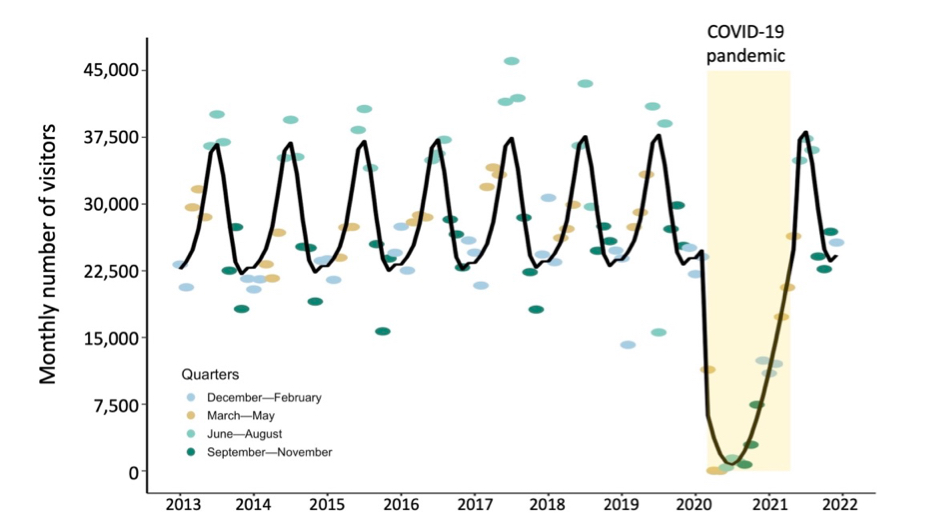COVID shutdown allows study of tourism’s impact on Hawai`i fishes
Dip in visitation benefits reef fish in a high-use marine protected area
During August 2019, more than 40,000 tourists visited Hawai`i’s Molokini island to snorkel or dive. In March 2020 the worldwide COVID lockdown dropped that number to zero.
The sudden and prolonged drop in visitors to one of the world’s most popular snorkeling spots provided scientists with a novel opportunity to study how underwater tourism impacts marine fishes. The results of their study, published in today’s issue of PLOS One, will help resource managers better care for Molokini and other threatened marine habitats.
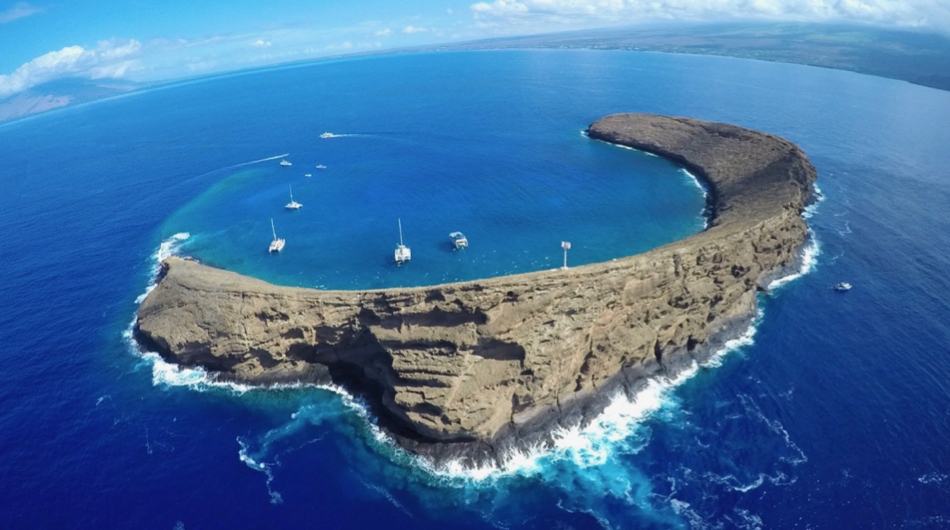 The study’s lead author, Dr. Kevin Weng of William & Mary’s Virginia Institute of Marine Science, says “The COVID-related tourism freeze provided a unique natural experiment to measure the effects of decreased tourism on fish behavior in a high-use, no-take marine protected area.” Joining Weng on the study were Dr. Alan Friedlander and Whitney Goodell of the National Geographic Society and Dr. Laura Gajdzik and Russell Sparks of the Hawai`i Department of Land and Natural Resources. Friedlander and Goodell are also affiliated with the University of Hawai`i at Mānoa.
The study’s lead author, Dr. Kevin Weng of William & Mary’s Virginia Institute of Marine Science, says “The COVID-related tourism freeze provided a unique natural experiment to measure the effects of decreased tourism on fish behavior in a high-use, no-take marine protected area.” Joining Weng on the study were Dr. Alan Friedlander and Whitney Goodell of the National Geographic Society and Dr. Laura Gajdzik and Russell Sparks of the Hawai`i Department of Land and Natural Resources. Friedlander and Goodell are also affiliated with the University of Hawai`i at Mānoa.
Molokini, which lies about 3 miles off the shore of Maui, was designated as a “no-take” marine protected area or MPA in 1977 based on tour operators' concerns regarding the impacts of fishing and other “consumptive” uses. “Tour operators have always been interested in the conservation of Molokini, and have partnered with the State on several measures," says Sparks. As the volume of “non-consumptive” uses such as snorkeling and SCUBA diving increased, tour operators worked with state officials to establish a limited-entry permit system for tour boats and install permanent moorings to protect corals from boat anchors.
The current study focused on the impacts of these non-consumptive uses. “Our research demonstrates that human presence alone can alter the community structure and possibly the functioning of an ecosystem,” says Weng. “This means we can improve how tourism is configured in Hawai`i and around the world to reduce the impacts of human presence.”
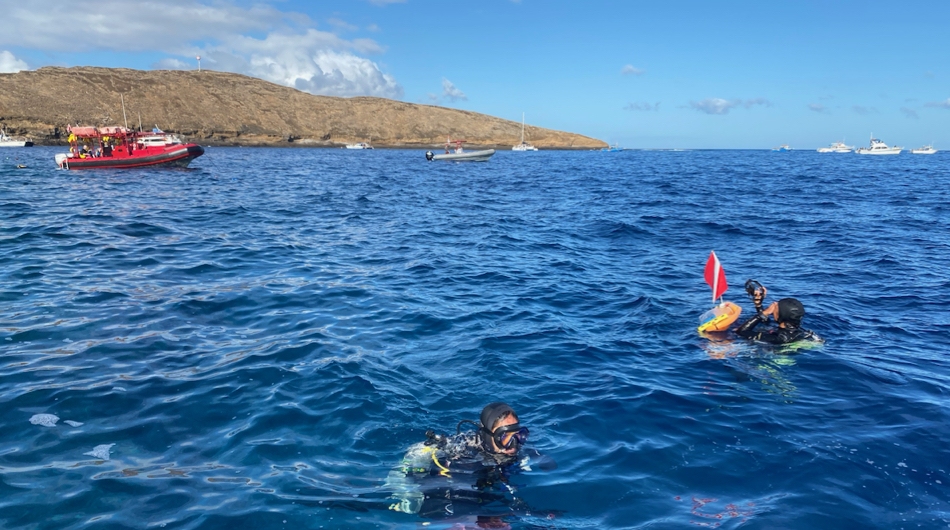
Community structure refers to the type and numbers of species present in an ecosystem. During Hawai`i’s COVID lockdown—which began at full force in March of 2020 and was then slowly lifted until visitation returned to pre-pandemic levels in May of 2021—the researchers conducted SCUBA surveys on five separate occasions to record the species, abundance, size, and location of predatory and herbivorous fishes within Molokini’s submerged crater. They also tracked the movement of the predatory species using electronic tags. Comparing these observations with data from similar surveys conducted in the years before and after the lockdown allowed them to detect differences in fish community structure caused by human presence. The researchers gathered data on human presence using logbooks kept by the 40 charter boat companies permitted to bring tourists into Molokini’s waters.
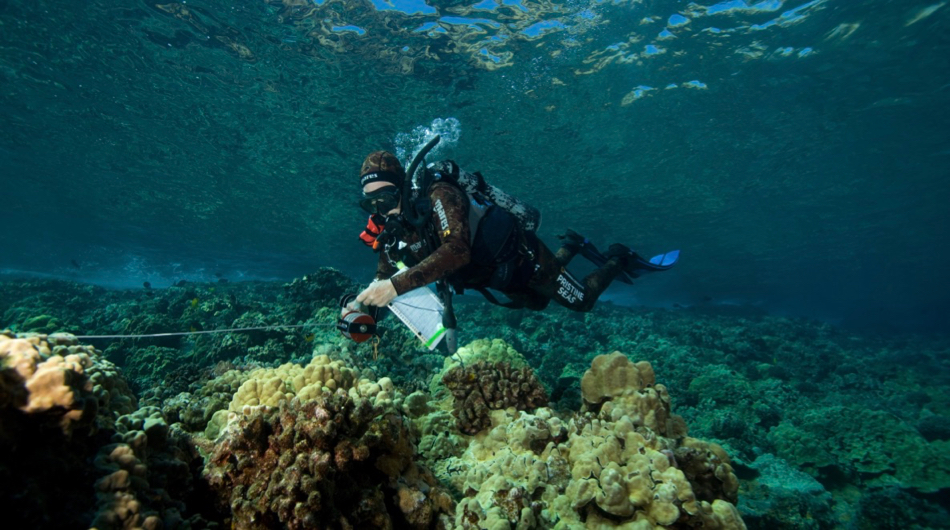
The results of this natural experiment were clear. “When tourism shut down due to COVID,” says Friedlander, “species that had been displaced from shallow habitats by high human presence moved back in on a timescale of months, increasing fish biomass as well as the proportion of larger predators." The species that mainly drove the observed increase in lockdown biomass were fast-swimming predatory fishes known as jacks, 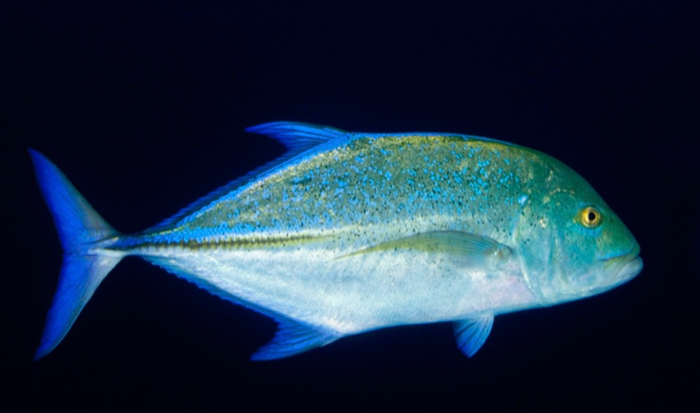 which learn to fear humans as they are often targeted by anglers. When tourism resumed, the predators moved to deeper waters, reducing fish biomass and habitat use to pre-pandemic levels. Biomass is a combined measure of fish abundance and size.
which learn to fear humans as they are often targeted by anglers. When tourism resumed, the predators moved to deeper waters, reducing fish biomass and habitat use to pre-pandemic levels. Biomass is a combined measure of fish abundance and size.
The observed changes in predator biomass were also reflected in the fishes’ behavior. Before the COVID lockdown, jacks were known to leave the inside of the crater during the morning peak in tourist visits. However, during the lockdown, they remained in the shallow, sheltered interior. These predators were quickly displaced from this shallow-water habitat when tourism resumed. Their displacement is particularly concerning because their summertime spawning season overlaps with the annual peak in marine tourism.
The human-induced displacement of predatory fishes from Molokini’s crater likely sends ripples throughout the local food web. Previous studies have shown that a drop in the abundance of predatory fishes affects not only the herbivorous fishes they count as prey, but the algae and other primary producers eaten by the herbivores. “Predators have diverse ecosystem roles,” says Friedlander, “and their loss can reduce the resistance and resilience of ecosystems to other stressors.”
{{youtube:large|U8LI70hwk9U, VIMS researcher Dr. Kevin Weng encounters a Bluefin trevally or omilu while descending to inspect a science instrument inside the Molokini Crater.}}
Overall, the team’s findings suggest that "Molokini is being over-used, and that management is needed to improve not only ecosystem health but the visitor experience," says Sparks. “Our findings indicate that the business-as-usual conditions of high tourism alter community structure by displacing predatory fishes to deeper environments,” adds Weng. Moreover, a 2011 study found that more than two thirds of visitors to Molokini felt crowded during their trip and supported actions that would reduce visitor numbers.
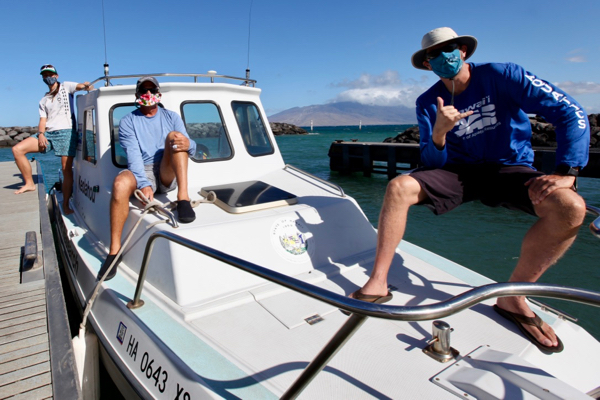
“As Hawai`i formulates marine management plans and undertakes the Sustainable Hawai`i Initiative,” says Gajdzik, “lessons from Molokini can help inform managers and help facilitate an effective response. As part of this process, we need to think strategically about the scale and configuration of tourism in Hawai`i to optimize earnings and employment without damaging the environment.”
“Our study indicates that the intensity of non-consumptive uses, especially in heavily visited MPAs, should be considered for the long-term health and resilience of these ecosystems,” says Weng. “Management of tourism should be guided by biological research, and include clear and well-enforced rules, adaptive management, and broad stakeholder involvement.”
| Weng KC, Friedlander AM, Gajdzik L, Goodell W, Sparks RT. (2023) Decreased tourism during the COVID-19 pandemic positively affects reef fish in a high use marine protected area. PLOS ONE 18(4): e0283683. https://doi.org/10.1371/journal.pone.0283683 |

